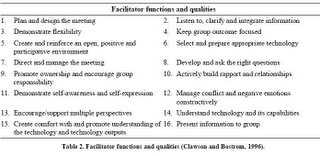Communities of Practice
Synchronicity is the middle name of my mail box. I got a post from Rosanna Tarsiero in the Group Facilitation List, directing my attention to Communities of Practice, CoP's. Halbana Tarmizi and Gert-Jan de Vreede published a paper called "A Facilitation Task Taxonomy for Communities of Practice" in the Proceedings of the Eleventh Americas Conference on Information Systems, Omaha, NE, USA August 11th-14th 2005.What are these CoP's? They define:
"Communities of Practice (COP) are social structures that focus on knowledge creating and sharing and explicitly enable the management of knowledge to be placed in the hands of practitioners (Wenger, 2004). COP have been identified as playing a critical role in the promotion of learning and innovation in contemporary organizations Swan, Scarborough and Robertson, 2002). However, establishing and sustaining COP within organizations is not a trivial task."
We can agree with this. There is, they say, an increasing interest in institution to create these CoP's. But we intend the participants of ABC to leave with a sense of purpose, a purpose to put their ideas into communal practice. We intend to learn people how to create a CoP as a facilitator. How? They propose a four stage model:
"Therefore, our life cycle stage model for COP has the following four stages:
1. The potential stage, when potential members or sponsors explore the possibility and desirability of setting up a COP;
2. The building stage, when the community is set up but has not officially started, e.g., it may run as a pilot community;
3. The active stage, when the community has officially started, takes off, shows rapid growth, and becomes a routine part of the organization; and
4. The inactive stage, when the community may exist, although the members are no longer active and no longer use the community."
So, the ABC is now in stage 1, a kind of Winter; the conference itself will be stage 2, it isMarch, so Spring is in the air. The participants will be prepared for stage 3: Summertime. Stage 4, of course, is the Autumn stage. Here the authors make a mistake: there is still activity. It is reaping the fruit of the CoP.
They also have some information on assisting roles for CoP's. They tell us (emphasized by me):
"In a case study of COP at 18 firms, Fontaine (2001) identified the following key roles within a COP:
The ‘facilitator’ role, which is the most time consuming role with up to 53.4% of a person’s assigned work time per week, followed by
the ‘admin/event coordinator’ role and
the ‘technologist’ role with 26% and 25%, respectively."
So, that is interesting - and also the division of labour for the conference. What is the facilitator role?
"According to Fontaine (2001, p.18) the facilitator role is responsible to “network and connect community members by encouraging participation, facilitating and seeding discussions and keeping events and communities activities engaging and vibrant” (p.18). It appears that a facilitator can play a crucial role in addressing the challenges in stablishing and nurturing a COP (Fontaine, 2001; Kimball and Ladd 2004)."
And:
"This leads to a number of important questions: What exactly constitutes the facilitator role?"
Here they become a bit technical - or is it scientific - and they start to mention model after model. It seems that this table is core: (click for an enlargement)
 It looks more complicated, than it is, I think.
It looks more complicated, than it is, I think.For more information, here is the link:
link to article
More on CoP:
http://www.funderstanding.com/communities_of_practice.cfm


0 Comments:
Post a Comment
<< Home